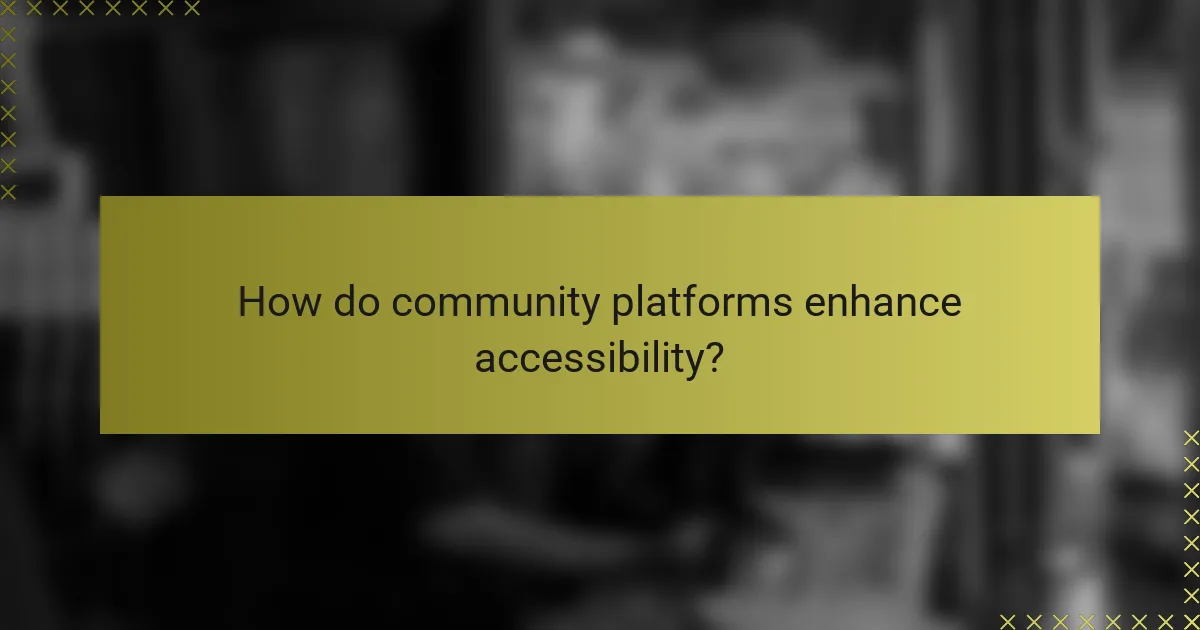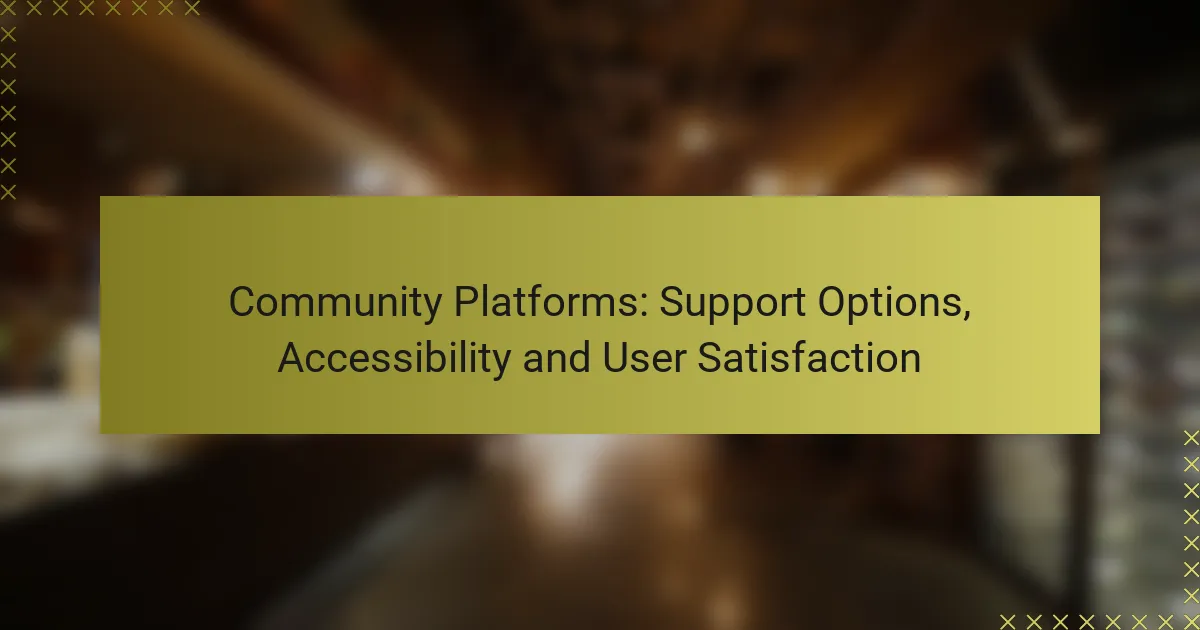Community platforms play a crucial role in fostering user engagement and support, with options like Discord, Facebook Groups, Reddit, and Slack catering to various interaction styles. Accessibility features such as mobile apps and screen reader compatibility ensure that all users can participate, while factors like responsive customer service and user-friendly interfaces significantly enhance overall satisfaction. Choosing the right platform is essential for meeting specific community needs and promoting a positive experience for all members.

What are the best community platforms for user support?
The best community platforms for user support include Discord, Facebook Groups, Reddit, and Slack, each offering unique features tailored to different engagement needs. Choosing the right platform depends on your target audience, the type of interaction desired, and the specific support requirements.
Discord for real-time engagement
Discord is ideal for real-time engagement, allowing users to communicate via text, voice, and video in dedicated channels. This platform is particularly effective for communities that thrive on immediate feedback and interaction, such as gaming or tech support groups.
To maximize user support on Discord, create specific channels for different topics or issues. Encourage users to ask questions and share solutions in a structured manner to keep conversations organized and accessible.
Facebook Groups for broad reach
Facebook Groups provide a vast reach, making them suitable for communities looking to engage a wide audience. With billions of users, this platform allows for easy sharing of posts, events, and resources, facilitating community building and support.
When using Facebook Groups for support, ensure you set clear guidelines for interaction. Regularly post updates and encourage members to share their experiences, which can foster a supportive environment and increase user satisfaction.
Reddit for niche discussions
Reddit excels in hosting niche discussions, making it a great choice for specialized communities. Subreddits allow users to dive deep into specific topics, providing a platform for detailed questions and expert answers.
To leverage Reddit for user support, create a dedicated subreddit for your community. Engage with users by responding to queries and encouraging discussions, while also adhering to Reddit’s community guidelines to maintain a positive atmosphere.
Slack for professional collaboration
Slack is designed for professional collaboration, making it suitable for teams and organizations that require structured communication. Its integration with various tools enhances productivity and allows for efficient support workflows.
For effective user support on Slack, organize channels by project or topic and utilize features like threads to keep discussions focused. Regularly check in with team members and encourage feedback to improve the support experience.

How do community platforms enhance accessibility?
Community platforms enhance accessibility by providing features that cater to diverse user needs, ensuring everyone can participate fully. These enhancements include mobile applications, screen reader compatibility, and support for multiple languages, making it easier for users with varying abilities and backgrounds to engage.
Mobile app availability
Mobile app availability is crucial for accessibility as it allows users to access community platforms on the go. Many platforms offer dedicated apps that are optimized for mobile devices, providing a user-friendly interface that simplifies navigation and interaction.
When choosing a community platform, consider whether it has a mobile app and how well it functions. Look for features like offline access and push notifications, which can enhance user engagement and ensure timely participation.
Screen reader compatibility
Screen reader compatibility is essential for visually impaired users, allowing them to navigate community platforms using audio feedback. Platforms that adhere to Web Content Accessibility Guidelines (WCAG) typically include features that support screen readers, such as proper labeling of buttons and images.
To ensure a platform is screen reader friendly, test it with popular screen readers like JAWS or NVDA. Check for clear navigation and whether all content is accessible, as this can significantly impact user satisfaction and engagement.
Multi-language support
Multi-language support broadens accessibility by allowing users from different linguistic backgrounds to engage with community platforms. This feature is particularly important in diverse regions, where users may prefer content in their native language.
When evaluating a community platform, consider the range of languages offered and the quality of translation. Platforms that provide user-generated content in multiple languages can foster a more inclusive environment, enhancing overall user satisfaction and participation.

What factors contribute to user satisfaction in community platforms?
User satisfaction in community platforms is primarily influenced by responsive customer service, a user-friendly interface, and active moderation policies. These elements work together to create a supportive and engaging environment for users, enhancing their overall experience.
Responsive customer service
Responsive customer service is crucial for addressing user concerns and fostering satisfaction. Quick and effective support can resolve issues before they escalate, leading to a more positive perception of the platform.
Consider offering multiple support channels, such as live chat, email, and forums, to cater to different user preferences. Aim for response times within a few hours to ensure users feel valued and heard.
User-friendly interface
A user-friendly interface significantly impacts user satisfaction by making navigation intuitive and enjoyable. Platforms should prioritize clear layouts, easy access to features, and minimal loading times to enhance usability.
Implementing responsive design ensures that the platform works well on various devices, from desktops to smartphones. Regular user testing can help identify pain points and areas for improvement in the interface.
Active moderation policies
Active moderation policies are essential for maintaining a safe and respectful community environment. Clear guidelines on acceptable behavior help users feel secure and encourage positive interactions.
Establish a team of moderators who can promptly address violations and provide feedback to users. Transparency in moderation actions can build trust and contribute to a more engaged user base.

What are the pricing models for community platforms?
Community platforms typically offer various pricing models to cater to different user needs and budgets. The most common models include free tiers with limited features, subscription-based pricing, and pay-per-use options, each with its own advantages and considerations.
Free tiers with limited features
Many community platforms provide free tiers that allow users to access basic functionalities without any cost. These free versions often come with restrictions, such as limited storage, fewer customization options, or a cap on the number of users.
For instance, platforms like Discord and Slack offer free plans that are suitable for small groups but may lack advanced features like analytics or integrations. Users should evaluate whether the limitations of the free tier meet their community’s needs before committing.
Subscription-based pricing
Subscription-based pricing is a popular model where users pay a recurring fee, typically monthly or annually, for access to a wider range of features. This model often includes tiered plans that provide varying levels of service, from basic to premium.
For example, platforms like Mighty Networks and Circle offer subscriptions that unlock advanced tools such as member management, analytics, and enhanced support. Users should consider their budget and the specific features they require when selecting a subscription plan.
Pay-per-use options
Pay-per-use options allow users to pay only for the features or services they actually use, making it a flexible choice for communities with fluctuating needs. This model can be beneficial for those who want to avoid fixed costs associated with subscriptions.
Platforms like Eventbrite and Meetup utilize this model, charging fees based on ticket sales or event registrations. Users should carefully assess the potential costs based on their expected usage to avoid unexpected expenses.

How to choose the right community platform?
Choosing the right community platform involves understanding your audience, the features you need, and how well the platform integrates with your existing tools. Prioritize user experience and accessibility to ensure high engagement and satisfaction.
Assess user demographics
Understanding your user demographics is crucial for selecting a community platform that meets their needs. Consider factors such as age, location, and technical proficiency, as these will influence the platform’s design and functionality.
For instance, younger users may prefer platforms with mobile-friendly interfaces and social media integration, while older demographics might value simplicity and ease of use. Collecting data through surveys or analytics can help you make informed decisions.
Evaluate feature sets
Different community platforms offer varying features, so it’s essential to evaluate what is necessary for your community. Look for features like discussion forums, private messaging, multimedia sharing, and moderation tools.
Make a checklist of must-have features versus nice-to-have ones. For example, if your community focuses on knowledge sharing, robust search functionality and tagging systems are critical. Compare platforms based on these criteria to find the best fit.
Consider integration capabilities
Integration capabilities are vital for ensuring a seamless user experience across different tools. Check if the community platform can integrate with your existing software, such as CRM systems, email marketing tools, or analytics platforms.
Platforms that offer APIs or built-in integrations can save time and enhance functionality. For example, if you use a specific email service for newsletters, ensure the community platform can connect with it to automate communications and updates.

What are the prerequisites for launching a community platform?
Launching a community platform requires careful planning and specific prerequisites to ensure its success. Key considerations include defining the target audience, selecting the right technology, and establishing clear goals for engagement and support.
Defining target audience
Identifying your target audience is crucial for the success of a community platform. Understanding who your users are helps tailor content, features, and interactions to meet their needs effectively.
Consider demographics such as age, interests, and geographic location. For instance, a platform aimed at young professionals in urban areas may prioritize networking features, while one for hobbyists may focus on sharing resources and experiences.
Engage with potential users early through surveys or focus groups to gather insights. This feedback can guide the platform’s design and functionality, ensuring it resonates with the intended audience and fosters active participation.



